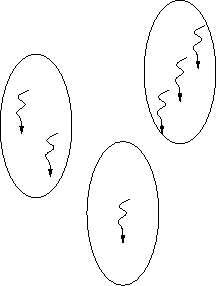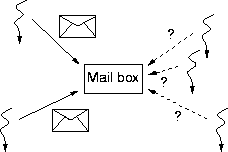- What is concurrency?
- Sequential Computations.
- Communication
- Synchronization
- Operating System Concurrency.
- Concurrency characteristics.
- Explicit and implicit concurrency.
- Synchronous and asynchronous concurrency.
- Concurrency classes.
- Concurrency (via Merriam-Webster):
- The simultaneous occurrence of events.
- Agreement or union in action.
- Life is concurrent.
- Concurrency pops up all over the place.
- Computational structures.
-
while !eof() { read; process; write }
- Computational properties.
- Why bother?
- Concurrency can be "more natural" than non-concurrency.
- Concurrency can be faster than non-concurrency.
- Doing n things with one or n people.
- A sequential computation is
- an instruction list,
- a data set, and
- a program counter.
- The instruction list is the computation's program.
- The data set is the computation's state.
- The data set consists of global, local, and heap variables.
- The program counter and a few other odds and ends are occasionally
included in a computation's state.
- The program counter the computation's thread of execution.
- This is all we care about sequential computations.
- The instructions and the state are the important parts.
- A concurrent computation is a sequential computation with more than one
thread of execution.
- A multi-threaded computation.
- Each thread executes at its own rate.
- Each thread shares the same state.
- A concurrent computation can also consist of more than one sequential
computation.
- Each may be multi-threaded or not.

- That's it? A bunch of threads?
- The constituent computations must communicate.
- Not all the time, and not necessarily regularly.
- But at least once, and maybe repeatedly.
- The amount of communication is important.
- Communication is slower than computation.
- The kind of communication is important.
- Intra-computation communication is much faster (x100) than
inter-computation communication.
- Threads and communication. Anything else?
- What can go wrong with communication?

- No senders, too many receivers, no receivers.
- Successful communication requires synchronization.
- And there's the rub.
- Concurrency needs communication.
- Communication needs synchronization.
- Synchronization kills concurrency.
- OSs have long been involved with concurrency.
- Ad hoc methods initially.
- Eventually more formal approaches.
- OSs must tame concurrency for itself.
- OSs must make concurrency available for users.
- Sequential parts:
- Main CPU, device controllers.
- Communication parts:
- Registers, memory-mapped I-O.
- Synchronization parts:
- Sequential parts:
- Communication parts:
- Shared memory, messages, files.
- Synchronization parts:
- Signals, semaphores, blocking I-O.
- How do you indicate concurrent execution?
- The programmer tells the compiler.
- Explicit (or imperative) concurrency.
-
dopar { read // process // write }
- The compiler tells the programmer.
- Implicit (or declarative) concurrency.
-
(1 + 1)*(2 + 2)
- Implicit is better than explicit.
- There's too much bookkeeping for humans.
- Explicit is more practical than implicit.
- Concurrency is too hard for compilers.
- These facts should make you nervous.
- A marching band, a marathon. What's the difference?
- A marching band is synchronous.
- Everybody steps at the same time.
- Everybody starts and stops at the same time.
- A marathon is asynchronous.
- Nobody steps at the same time.
- Nobody starts and stops at the same time.
- Synchronous concurrency runs in lock-step.
- The same set of instructions.
- Synchronous concurrency needs hardware.
- Asynchronous concurrency free-wheels.
- The execution ratio of any two constituent computations is arbitrary.
- This is as close to time as we're going to get.
- Synchronous concurrency is easy to program but possibly slow.
- Each knows where everybody else is.
- Each can only go as fast as the slowest person.
- Asynchronous concurrency is hard to program but possibly fast.
- Nobody knows where hardly anybody is.
- Each goes at their best pace.
- This course is about asynchronous concurrency.
- Communication speed distinguishes concurrency classes.
- Parallel programs have fast (nanosecond) communication.
- Scientific computation.
- Vector, pipelined, and other CPU architectures.
- Concurrent programs have medium (microsecond) communication.
- Multi-threaded and multi-process computations.
- Uni- and multi-processor systems.
- Distributed programs have slow (millisecond and up) communication.
- Client-server and peer-to-peer systems.
- The Internet and other networks
- Concurrency is everywhere.
- Concurrency is sequential computations, and communication and
synchronization.
- Balancing computations, communication, and synchronization is the trick.
- Concurrency can be explicit or implicit.
- Explicit is hard but fast, implicit is easy but slow.
- Concurrency can be synchronous or asynchronous.
- Asynchronous is hard but fast, synchronous is easy but slow.
- Parallel, concurrent, and distributed computations.
- The difference is the communication speed.
This page last modified on 27 May 2003.


